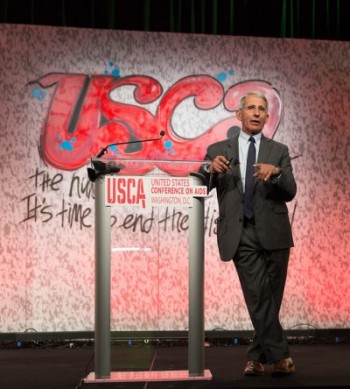Spotlight on the Updated National HIV/AIDS Strategy at USCA 2015
Content From: Miguel Gomez, Director, AIDS.gov, and Senior Communications Advisor, Office of HIV/AIDS and Infectious Disease Policy, U.S. Department of Health and Human Services•Published: September 11, 2015•3 min read
Topics
The National HIV/AIDS Strategy: Updated to 2020 was in the spotlight during a plenary session of the 2015 U.S. Conference on AIDS in Washington, DC, yesterday (September 10, 2015). The annual conference, sponsored by the National Minority AIDS CouncilExit Disclaimer, has assembled nearly 3,000 participants from across the country in Washington, DC.

- Retained the original vision and four national goals.
- Integrates two Presidential orders issued in support of the original Strategy: the HIV Care Continuum Initiative and the Federal Inter-agency Working Group on the Intersection of HIV/AIDS, Violence Against Women and Girls, and Gender-related Health Disparities.
- Builds on the progress and lessons from implementing the 2010 Strategy and build on the improved federal collaboration.
- Seeks to leverage some major advances since the launch of the original Strategy including the many benefits of the Affordable Care Act for people at risk for or living with HIV, scientific discoveries that have expanded our prevention toolkit and recommended treatment for all who test positive.
- Focuses our national response on the right people, right places, and right practices .
- Establishes 10 indicators to will be used to monitor our progress and proposes the creation of 3 developmental indicators.
Mr. Brooks also announced that he had just launched his Twitter account, and invited those interested in knowing more about the Strategy and the national response to HIV/AIDS to follow him at @DMBrooks44Exit Disclaimer.

These goals, he explained, are achievable, but will require, in particular, the effective application of advances in ART to both treatment and prevention. He reviewed recent studies that have demonstrated the effectiveness of ART, including the START study that found that beginning ART early (soon after diagnosis) improves outcomes for HIV-infected individuals, and other recent studies that have found that treatment is highly effective at preventing sexual transmission of HIV to uninfected heterosexual partners released last week by Kaiser Permanente indicating that over 2.5 years of observation of a cohort of individuals using PrEP found no new HIV infections among patients. These findings underscore the important role that PrEP will play in meeting our national HIV goals, as called for in the updated Strategy.
Dr. Fauci concluded his presentation by observing that ending the HIV epidemic is no longer just a feasible goal, but an inevitable one if we apply the best science to our efforts.
Here on the blog, we will continue to share highlights from USCA 2015 in the coming days.